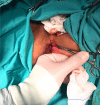Comparative Analysis of Open and Closed Sphincterotomy for the Treatment of Chronic Anal Fissure: Safety and Efficacy Evaluation
- PMID: 38679898
- PMCID: PMC11064732
- DOI: 10.12659/MSM.944127
Comparative Analysis of Open and Closed Sphincterotomy for the Treatment of Chronic Anal Fissure: Safety and Efficacy Evaluation
Abstract
BACKGROUND Chronic anal fissure is a common condition that causes pain and discomfort and has a significant impact on quality of life. When conservative management fails, surgical sphincterotomy can be successful. This retrospective study from a single center in Turkey included 188 patients with chronic anal fissures and aimed to compare outcomes from open and closed sphincterotomy. MATERIAL AND METHODS This retrospective study included 188 patients treated with lateral internal sphincterotomy (LIS) for chronic anal fissure between January 2015 and December 2021 in our hospital. Open LIS procedure was performed in 91 patients and closed LIS was performed in 97 patients. Demographic characteristics, postoperative complications, and recurrence were compared for these 2 methods. RESULTS Of the 188 patients included in the study, 47.9% were women and 52.1% were men. The mean age was 42.9 (20-84) years. In the open LIS group, recurrence occurred in 2 patients (2.19%), and no incontinence was observed. In the closed LIS group, recurrence occurred in 3 patients (3%; P=0.703), and incontinence developed in 5 patients (5.15%; P=0.035). CONCLUSIONS Comparing the 2 methods used in chronic anal fissure surgery, and considering the recurrence and risk of incontinence, the most feared outcome by the patient and surgeon, open LIS stands out as a superior technique, especially in young male patients.
Conflict of interest statement
Figures





Similar articles
-
Treatment of chronic anal fissure: Is open lateral internal sphincterotomy (LIS) a safe and adequate option?Asian J Surg. 2019 May;42(5):628-633. doi: 10.1016/j.asjsur.2018.10.001. Epub 2018 Oct 24. Asian J Surg. 2019. PMID: 30366766
-
Modified open posterior internal sphincterotomy with sliding skin graft for chronic anal fissure and anal stenosis: Low recurrence rate and no serious faecal incontinence postoperative complication.J Visc Surg. 2022 Aug;159(4):267-272. doi: 10.1016/j.jviscsurg.2021.07.002. Epub 2021 Jul 21. J Visc Surg. 2022. PMID: 34303637
-
Botulinum toxin injection versus lateral internal sphincterotomy for the treatment of chronic anal fissure: randomized prospective controlled trial.Langenbecks Arch Surg. 2012 Oct;397(7):1093-8. doi: 10.1007/s00423-012-0948-2. Epub 2012 Mar 20. Langenbecks Arch Surg. 2012. PMID: 22430300 Clinical Trial.
-
Comparing closed versus open lateral internal sphincterotomy for management of chronic anal fissure: systematic review and meta-analysis of randomised control trials.Sci Rep. 2023 Nov 28;13(1):20957. doi: 10.1038/s41598-023-48286-z. Sci Rep. 2023. PMID: 38017243 Free PMC article.
-
Update on the management of anal fissure.J Visc Surg. 2015 Apr;152(2 Suppl):S37-43. doi: 10.1016/j.jviscsurg.2014.07.007. Epub 2014 Oct 8. J Visc Surg. 2015. PMID: 25305752 Review.
References
-
- Wienert V, Raulf F, Mlitz H. Anal fissure: Symptoms, diagnosis and therapies. Chan, Switzerland: Springer International Publishing AG; 2017.
-
- De Robles MS, Young CJ. Real world outcomes of lateral internal sphincterotomy vs botulinum toxin for the management of chronic anal fissures. Asian J Surg. 2022;45(1):184–88. - PubMed
-
- Wiley M, Day P, Rieger N, et al. Open vs. closed lateral internal sphincterotomy for idiopathic fissure-in-ano: A prospective, randomized, controlled trial. Dis Colon Rectum. 2004;47(6):847–52. - PubMed
Publication types
MeSH terms
LinkOut - more resources
Full Text Sources

